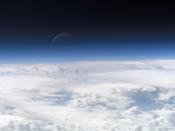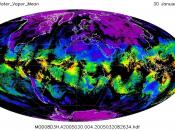The Atmosphere
Soon after its formation (about 4,500 million years ago) Earth may have resembled present day Jupiter or one of the other giant planets, with a thick layer of gases surrounding a very dense core. In a place of the cosmic gases a secondary atmosphere developed, deriving from the earth itself. For many millions of years after its formation, the earth's surface was probably molten and, even after a thin outer crust had solidified, there was incessant volcanic action. During this period of great activity, the rocks gave off large quantities of gases, including nitrogen, ammonia, carbon monoxide and water vapor as well- a mixture similar to that given off by volcanoes and fumaroles today. Like modern volcanic gases, the primeval atmosphere is thought to have contained only the slightest trace of oxygen, and so it would have been poisonous to almost all modern life forms.
Oxygen and Photosynthesis
The earth gradually cooled, and after its surface temperature had fallen to below 212 degrees F.
(100 degrees C), water vapor in the atmosphere condensed and fell as rain, which filled hollows and created shallow lakes and seas. In these waters, at depths of more than 33 feet (10 meters), the limit of penetration by lethal ultraviolet radiation, the first primitive plants evolved. They produced their own food by photosynthesis (a form of metabolism in which light is used to convert inorganic molecules such as carbon dioxide and water into more complex organic molecules, such as sugar), and released oxygen into the atmosphere.
In the air molecules of oxygen were broken down by ultraviolet radiation into single atoms, and some of these atoms combined with oxygen molecules to form ozone. Ozone is an unstable gas, the molecules of which absorb ultraviolet radiation.
The Modern Atmosphere
The chief gases in the...



The Earth's Atmosphere
Not sure where you got your information, howerver the earth is quite older than 4.5 million years old. They have found fossils older than that in Africa resently. I am pretty sure your instructor would have got that info thus not rating you with a 4.0. Perhaps 4.6 billion years. Check this gov site. http://www.newton.dep.anl.gov/askasci/gen99/gen991 68.htm
1 out of 1 people found this comment useful.